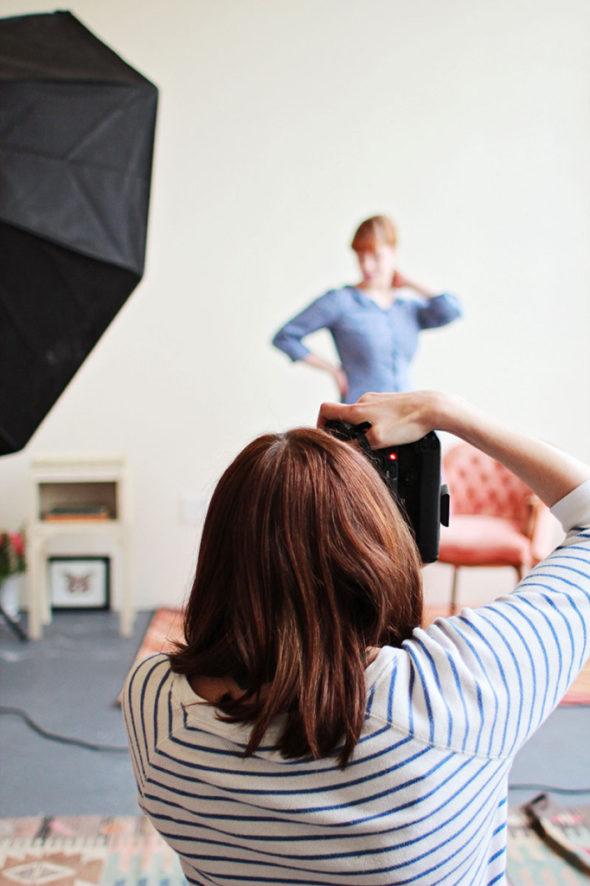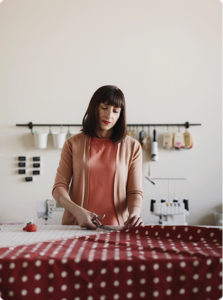
Photo courtesy of Sarai Mitnick
At Submittable, we get the privilege and fun of working with many creative people in publishing, filmmaking, and more. I recently interviewed our client Sarai Mitnick, who is a rock star in the indie sewing world. A former Silicon Valley techie, Sarai moved to Portland, Oregon, in 2008 to found Colette Patterns, which has grown to be one of the most popular indie sewing pattern companies, especially for Gen X and millennial sewing aficionados. The patterns are known for their modern feel and user-friendly instructions, which makes sense, given Sarai’s background in user experience. Sarai also runs a thriving blog, published The Colette Sewing Handbook for new sewists in 2011, and will soon launch Seamwork, an online pattern magazine which is currently calling for submissions.
Asta: As a sewist myself, I’m a big fan of your blog and book. Can you tell us about Colette Patterns and why you started it?
Sarai: At the time, I was working at Google as a User Experience Researcher, meaning that I spent a lot of time observing and thinking about people’s everyday needs and problems around technology. I’d become increasingly interested in starting my own creative business, and had been sewing for many years. It seemed to me that most of the patterns out there were not designed to meet the needs of people like me. They weren’t modern or interesting, the fit was really baggy, and they just didn’t feel special in the way I thought a sewing project should feel. I mean, you’re investing so much time in each thing you sew, I thought it should really feel worthy of the investment. I also noticed that many people were learning to sew through patterns, but the patterns weren’t really designed to teach anything. It was sort of sink or swim, and that’s a time consuming way to learn a skill.
Asta: How does your background in technology influence your work as a founder, a sewist, a writer, a pattern designer?
Sarai: It helps in a few ways. First, my background in User Experience taught me a lot about what I think is the most important skill in my business – compassion. Having the capacity to care and the curiosity to investigate other people’s needs goes a long way toward building a sustainable business. Second, I think it’s made me less afraid of taking on massive projects, for better or worse. Third, it’s given me some insight into how people use technology to connect to one another, and that’s been incredibly valuable.
Asta: When did you start sewing? What appeals to you most about it?
Sarai: I began sewing when I was 16. My grandmother taught me, though much of my skill has been self-taught.
Clothing and fashion are often trivialized, but they’re such an important part of how we communicate with the world, and how we even understand ourselves. I like that sewing gives you so much power over this aspect of your life, the ability to create clothing that fits you in every way instead of just buying what you’re offered.

Photo courtesy of Sarai Mitnick
Asta: What are your thoughts about the state of the sewing world? How is it changing?
Sarai: Like many niche communities, it’s really found a home online! There is a huge world of sewing blogs, pattern companies, and online shops that did not exist when I started. It’s thriving!
Asta: There’s been a lot of talk lately about gender inequality and a lack of diversity in the tech world. Do you see similar issues playing out in the sewing world?
Sarai: Not exactly, though I do think gender norms come into play in both cases. It’s true that there aren’t a lot of men active in the sewing community, though that seems to be changing. I will say there are a surprising number of men at the helm of some large sewing or craft-based companies, though. I’d like to see a world where more men felt comfortable getting into sewing. Historically, things that are traditional “women’s work” are not considered very high status for men.
Asta: In your blog and book, you like to use the word “sewist” instead of “seamstress” or “sewer” (which, well, sounds like a sewer). Can you speak about this preference?
Sarai: I don’t particularly like “sewer” for the reason you point out. And “seamstress” is a lovely word, but a gendered one, so I prefer the more inclusive “sewist.”
Asta: Tell us about Seamwork, your new online sewing pattern magazine. What made you start it?
Sarai: I’ve long been interested in beginning a new kind of sewing publication. There are some wonderful print magazines on the market, but I felt there was room for a new voice and aesthetic in the mix. What I really wanted to do is to mix patterns and articles in a way that makes sense to people. We’ve done that somewhat with our blog, where we post tutorials and other supporting content that can go with our patterns. This is sort of taking it to the next level. The idea had been percolating for years, but I didn’t know what form that would take until about a year ago. Even then, it’s evolved so much since and I imagine it will continue to change.
Asta: Who is the target audience for Seamwork? What kind of writing or submissions are you looking for?
Sarai: Our target audience is made up of sewing enthusiasts with an eye for style and desire to really enjoy their sewing experience. That’s the main thing I want to convey with Seamwork, the absolute pleasure that making your wardrobe can bring.
Asta: Lastly, what’s your favorite sewing tool?
Sarai: I have so many! But I love my thread nippers, which I wear on a ribbon around my neck whenever I’m sewing. Putting them on is sort of ceremonial for me.
